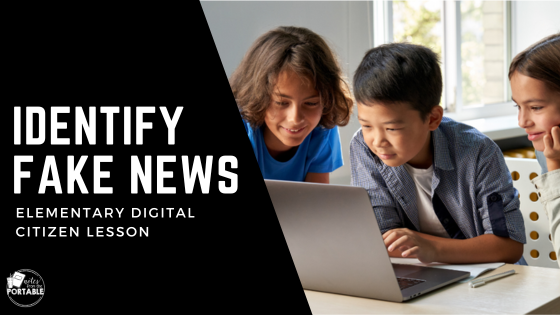
Helping students identify fake news is hard. Kids today have so much information available at the typing of a search, it is hard to figure out what information is correct and what is fake news.
Clicking on the top search these days could be a link that someone paid to have there or one that the writer was good at SEO (Search Engine Optimization) or used AI. It may lead breadcrumbs for us to find their content, but this may not be the best resource to use.
Helping Students Identify Fake News Step 1: Trusting Your Source
I hook kids in by playing the telephone game. I divide the class into two groups and tell them how to play the game, just in case a few don’t know.
I show one person a post-it note with something like “Hippos are my favorite animal” OR “I love converting fractions in math.”
I play music in the background, just to make it a little bit harder.
It is always fun to see what the last person hears. Very rarely do I get my phrase repeated correctly. We talk about trusting information that goes through several sources before you hear about this. (Sidenote – this is a quick way to talk about spreading rumors too).
I follow this up with the book Telephone by Mac Barnett.
Follow Up Question: Should you trust information that has traveled through many sources? What happened as the information was passed from person to person?
Helping Students Identify Fake News Step 2: What Is Fake News
Next I have students talk about what they know about Fake News. Have they had experience with it before?
This video is great at showing signs that something would be fake news.
What is fake news – explained l CBC Kids News
Follow this with having students create a list of sources they could trust.

Helping Students Identify Fake News Step 3: Fake News Examples
Present examples of having them assess if they believe if something is real.
Example 1: A friend tells you that Chick Fil A will be sold at lunch. Do you believe them? What are ways you could investigate if this information is real or fake? (Examples: ask the cafeteria people, look at the menu, etc.)
Example 2: A friend tells you that there was a family who had a dog that turned out to be a bear. Share with them this National Geographic Article. Do you believe this now? Why or why not?
Helping Students Identify Fake News Step 4: Follow Up
I like to test my students’ skill at identifying things that are fake and things that are real. This Photoshop Quiz is one where my students really learn that they are the best at finding what is real. This is a great way for them to think in the future if the image or text they see is something they should believe.
Teaching kids to identify fake news is important. Students today are presented with so much information. They need to be able to sift through the fake news to find truth.
More Digital Citizenship Ideas:
Leave a Reply